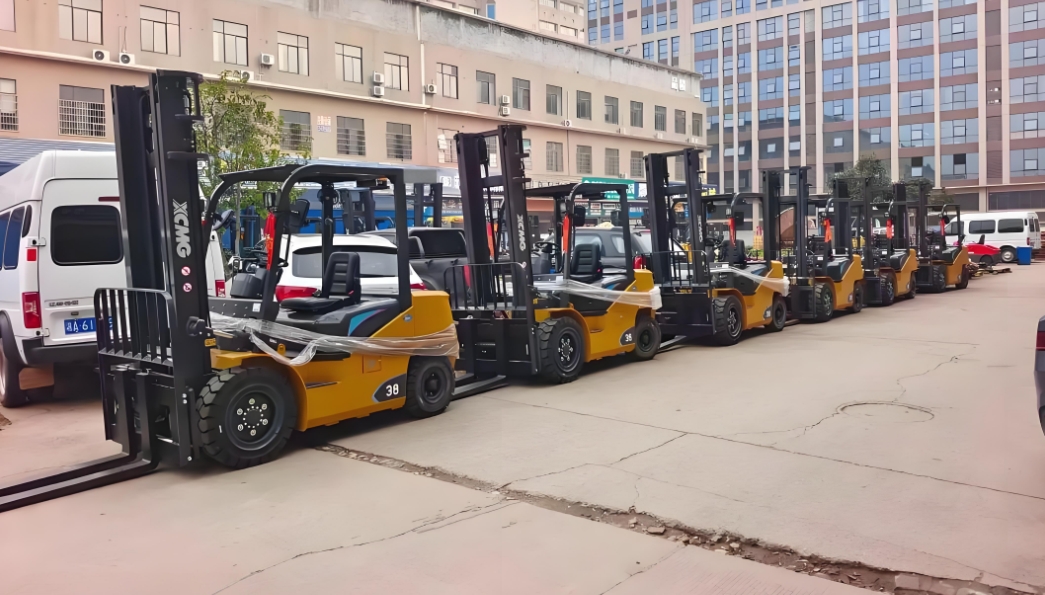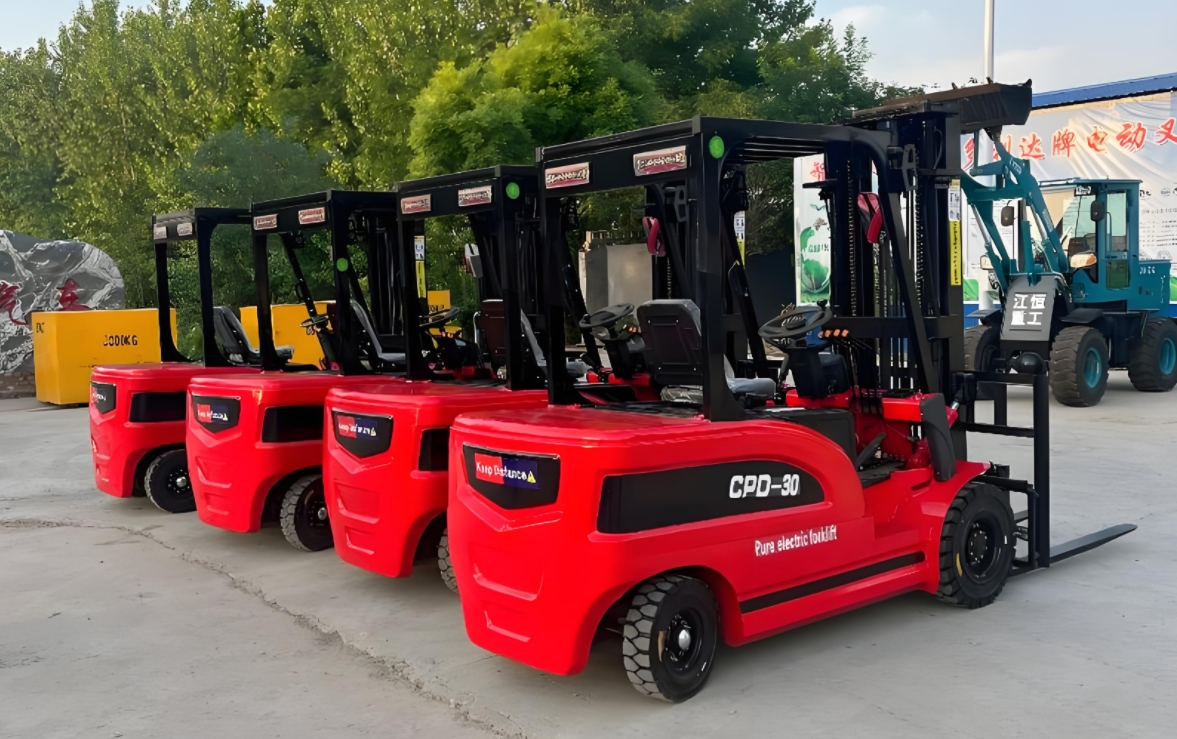Blog
Comprehensive Decision Guide for Renting and Purchasing Electric Forklifts

Forklift Lease vs Buy Complete Decision Guide: Financial Analysis and Strategic Planning
1. Introduction: The Strategic Equipment Acquisition Decision
The decision to lease or buy electric forklifts is a significant financial consideration that impacts operational efficiency, cash flow, and long-term business strategy. With the average lifespan of an electric forklift ranging from 5-10 years and costs ranging from $20,000 to $50,000+ per unit, this decision requires careful analysis of both financial and operational factors. This comprehensive guide provides a detailed framework for evaluating whether leasing or purchasing Yuweida electric forklifts is the right choice for your business needs.
Making the optimal decision requires understanding total cost of ownership, tax implications, flexibility needs, and technological considerations. Whether you’re managing a large fleet of warehouse equipment or specialized heavy-duty equipment, this guide will help you navigate the complex financial and operational considerations involved in equipment acquisition.
2. Understanding the Fundamental Options
2.1 Purchasing Options
- Outright Purchase: Full cash payment for equipment ownership
- Financed Purchase: Loan financing with ownership transfer
- Lease-to-Own: Lease agreements with purchase option
- Equipment Loan: Traditional equipment financing
- Line of Credit: Using business credit for purchase
2.2 Leasing Options
- Operating Lease: Short-term rental with maintenance included
- Financial Lease: Long-term lease with purchase option
- Full-Service Lease: Comprehensive maintenance and support
- Term Lease: Fixed-period rental agreement
- Flex Lease: Flexible terms with upgrade options
3. Financial Analysis Framework
3.1 Total Cost of Ownership Calculation
- Initial Costs: Purchase price vs. lease deposit and fees
- Monthly Payments: Loan payments vs. lease payments
- Maintenance Costs: Estimated repair and maintenance expenses
- Operating Costs: Energy consumption and consumables
- Residual Value: Expected equipment value at end of term
3.2 Cash Flow Analysis
- Upfront Investment: Capital required for purchase vs. lease
- Monthly Cash Impact: Effect on monthly operating cash flow
- Tax Implications: Different tax treatment of lease vs. purchase
- Opportunity Cost: Alternative uses of capital
- Budget Predictability: Certainty of future expenses
3.3 Net Present Value Analysis
- Discount Rate Application: Time value of money calculations
- Cash Flow Projections: Projected costs over equipment life
- Residual Value Consideration: End-of-life equipment value
- Tax Shield Effects: Impact of tax deductions on net cost
- Comparative Analysis: Side-by-side NPV comparison
4. Operational Considerations
4.1 Flexibility Requirements
- Seasonal Demand: Ability to adjust fleet size for demand fluctuations
- Technology Changes: Need to upgrade to newer technology
- Business Growth: Equipment scalability for expanding operations
- Project-Based Needs: Temporary equipment requirements
- Operational Changes: Adapting to changing business needs
4.2 Maintenance and Support
- In-House Capability: Existing maintenance infrastructure and expertise
- Warranty Coverage: Manufacturer warranty terms and duration
- Service Availability: Local service provider availability
- Downtime Impact: Cost of equipment downtime on operations
- Parts Availability: Access to genuine replacement parts
4.3 Technology Considerations
- Technology Lifecycle: Expected lifespan of current technology
- Innovation Pace: Rate of technological advancement in equipment
- Compatibility Needs: Integration with existing systems
- Future Requirements: Anticipated future operational needs
- Standardization Benefits: Fleet standardization advantages
5. Tax and Accounting Implications
5.1 Tax Treatment Differences
- Depreciation Benefits: Capital cost allowance for purchased equipment
- Lease Deductions: Operating lease payments as business expenses
- Section 179 Deduction: US tax provision for equipment purchases
- Investment Tax Credit: Potential credits for certain equipment
- VAT/GST Treatment: Different treatment for leases vs. purchases
5.2 Accounting Treatment
- Balance Sheet Impact: On-balance sheet vs. off-balance sheet treatment
- Asset Recognition: Capitalization of purchased assets
- Liability Recognition: Lease liability recognition under new standards
- Expense Recognition: Different expense recognition patterns
- Financial Ratios: Impact on key financial ratios and covenants
5.3 Compliance Requirements
- Lease Accounting Standards: ASC 842 and IFRS 16 compliance
- Disclosure Requirements: Financial statement disclosure rules
- Documentation Needs: Proper documentation for tax compliance
- Audit Preparedness: Maintaining records for audit purposes
- Reporting Obligations: Regular reporting requirements
6. Risk Assessment and Management
6.1 Financial Risks
- Interest Rate Risk: Exposure to changing interest rates
- Residual Value Risk: Uncertainty about future equipment value
- Credit Risk: Counterparty risk in lease agreements
- Liquidity Risk: Access to capital for unexpected needs
- Currency Risk: Foreign exchange exposure for imported equipment
6.2 Operational Risks
- Technology Obsolescence: Risk of equipment becoming outdated
- Maintenance Risk: Unexpected repair costs and downtime
- Performance Risk: Equipment not meeting operational needs
- Compliance Risk: Changing regulatory requirements
- Business Continuity: Equipment availability for critical operations
6.3 Mitigation Strategies
- Insurance Coverage: Equipment and business interruption insurance
- Service Agreements: Comprehensive maintenance agreements
- Upgrade Options: Technology refresh provisions
- Exit Strategies: Clear termination and exit provisions
- Contingency Planning: Backup equipment arrangements
7. Vendor Evaluation and Selection
7.1 Purchase Vendor Criteria
- Equipment Quality: Manufacturer reputation and reliability
- Pricing Competitiveness: Purchase price and financing terms
- Warranty Terms: Comprehensive warranty coverage
- Support Services: After-sales support and service
- Parts Availability: Genuine parts availability and pricing
7.2 Lease Provider Criteria
- Lease Terms: Flexible and competitive lease terms
- Service Inclusion: Maintenance and support services included
- Upgrade Options: Technology upgrade availability
- Financial Stability: Lessor financial strength and stability
- Customer Service: Responsiveness and support quality
7.3 Negotiation Factors
- Purchase Price: Negotiated equipment purchase price
- Lease Rates: Competitive lease rates and terms
- Maintenance Costs: Included or discounted maintenance services
- Warranty Extension: Extended warranty options
- Service Level Agreements: Guaranteed response times
8. Implementation Planning
8.1 Transition Planning
- Equipment Delivery: Coordinated delivery and installation
- Operator Training: Comprehensive operator training
- Maintenance Setup: Establishment of maintenance procedures
- Systems Integration: Integration with operational systems
- Performance Monitoring: Establishing performance metrics
8.2 Change Management
- Stakeholder Communication: Communicating with affected parties
- Training Programs: Equipment operation and maintenance training
- Process Updates: Updating operational procedures
- Documentation: Creating new documentation and manuals
- Performance Measurement: Establishing success metrics
8.3 Ongoing Management
- Performance Tracking: Monitoring equipment performance
- Cost Monitoring: Tracking actual vs. projected costs
- Maintenance Management: Managing maintenance schedules
- Contract Management: Administering lease agreements
- Renewal Planning: Planning for lease renewals or purchases
9. Case Studies and Real-World Examples
9.1 Small Business Scenario
- Business Profile: 10-20 person operation with seasonal fluctuations
- Analysis: Lease vs. purchase cost comparison
- Decision Factors: Cash flow, flexibility, tax considerations
- Outcome: Optimal solution and implementation results
- Lessons Learned: Key takeaways and recommendations
9.2 Large Enterprise Scenario
- Business Profile: 500+ person operation with consistent demand
- Analysis: Fleet purchase with financing analysis
- Decision Factors: Scale economies, maintenance control, total cost
- Outcome: Implementation experience and results
- Lessons Learned: Best practices and recommendations
9.3 Specialized Application Scenario
- Business Profile: Unique operational requirements
- Analysis: Custom equipment acquisition analysis
- Decision Factors: Specialization, technology, support needs
- Outcome: Specialized solution implementation
- Lessons Learned: Niche application insights
10. Decision Framework and Tools
10.1 Decision Matrix
- Financial Factors: Weighting and scoring financial considerations
- Operational Factors: Evaluating operational requirements
- Strategic Factors: Considering long-term strategic impact
- Risk Factors: Assessing and weighting various risks
- Total Score: Comprehensive decision scoring system
10.2 Calculation Tools
- TCO Calculator: Total cost of ownership calculation template
- Cash Flow Model: Projected cash flow analysis tool
- NPV Calculator: Net present value comparison tool
- Lease vs. Buy Calculator: Side-by-side comparison calculator
- Sensitivity Analysis: Scenario analysis and modeling tool
10.3 Implementation Checklist
- Pre-Decision Checklist: Items to complete before deciding
- Due Diligence Checklist: Verification and validation items
- Negotiation Checklist: Key points to negotiate
- Implementation Checklist: Steps for successful implementation
- Review Checklist: Ongoing management and review items
11. Conclusion: Making the Optimal Acquisition Decision
The decision to lease or buy electric forklifts requires careful consideration of financial, operational, and strategic factors. There is no one-size-fits-all answer—the optimal choice depends on your specific business circumstances, financial position, and operational needs. By following the comprehensive framework outlined in this guide and thoroughly analyzing your specific situation, you can make an informed decision that maximizes value and supports your business objectives.
Remember that the decision is not permanent—many businesses use a combination of leasing and purchasing strategies across their equipment fleet. Regular review of your equipment acquisition strategy ensures it continues to align with your evolving business needs and market conditions.
For personalized assistance with your Yuweida equipment acquisition decision or to explore specific financing options, contact our technical support team or consult our equipment procurement guide. The right acquisition strategy can provide significant competitive advantage and contribute to your long-term business success.

